Are you burnt out from countless hours spent crafting blog articles, social media posts, or product descriptions? Does the prospect of scaling your content give you more anxiety than anticipation? Maybe it’s time you discovered an innovative solution: automated content creation. Picture a world where high-quality content is produced at scale and your creative juices are reserved for strategic tasks rather than being spent on mundane, repetitive jobs. Feast your eyes on this explorative guide as I take you on a journey through the enthralling landscape of AI-automated content creation.
Definition and Concept of Automated Content Creation
What is automated content?
Automated content, sometimes referred to as machine-generated content, refers to any blogs, articles, or social media updates created by Artificial Intelligence (AI) instead of human authors. It’s not a futuristic fantasy but an existing technology employed across multiple sectors, such as journalism, e-commerce, education, and digital marketing.
What is automated content creation?
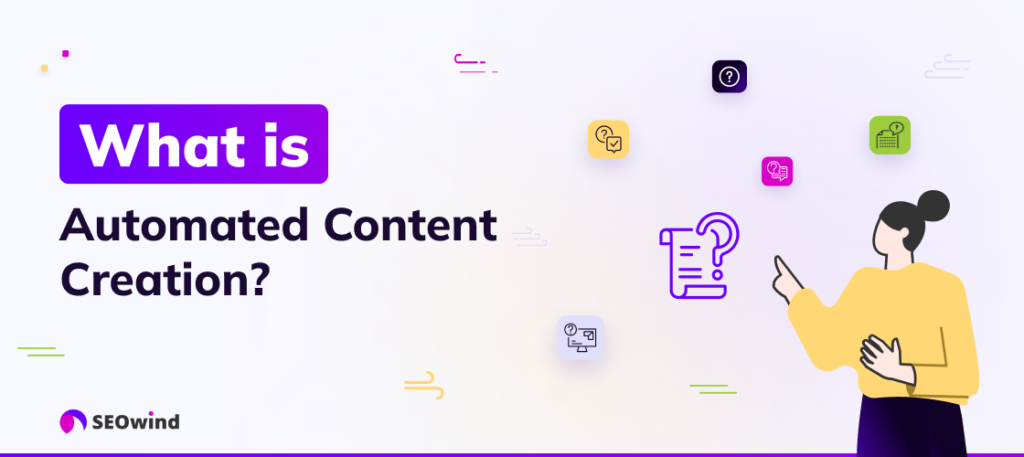
Automated content creation includes more than just producing ready-to-use text. It encompasses all processes streamlined by AI and machine learning algorithms to simplify the various stages involved in generating relevant text automatically without substantial human intervention.
This revolutionary approach extends beyond drafting requested texts; it also involves intricate processes like keyword research, generating title ideas, proofreading texts for errors or inconsistencies, translating contents into different languages—the list goes on!
AI content creation market size
According to Future Market Insights, the AI content creation tool market is estimated to be valued at US$ 840.3 million in 2024 and is predicted to rise at a CAGR of 13.60% from 2024 to 2034. By 2034, the global AI content creation tool market is anticipated to reach US$ 3,007.6 million, highlighting the rapid growth and increasing importance of this technology in the content creation landscape.
Intrigued so far? Let us begin our voyage further into the benefits that make automation an attractive proposition in today’s fast-paced environment.
Benefits of Automated Content Creation
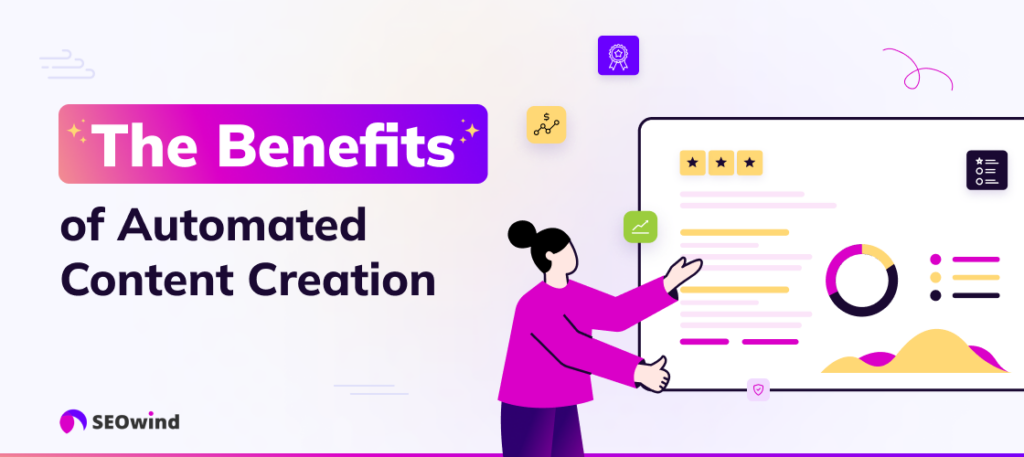
The shift towards automated content creation is not without reason. It’s driven by the numerous benefits that this revolutionary approach has to offer. By adopting this AI-powered method, brands can significantly augment their digital marketing strategies.
Time savings and increased efficiency
The most apparent advantage of automated content generation lies in the vast amount of time it saves. Creating quality content often requires hours, if not days — a task that AI can accomplish within minutes or even seconds. And while doing so, it does not compromise on the precision or quality of content. Consequently, businesses have more time to focus on other critical tasks, such as strategizing and implementation.
Consistency and quality control
In manual writing scenarios, maintaining consistency in tone, voice, and style over an extended period is challenging. However, automated content creation tools have been triumphant in these areas by guaranteeing standardization across all written materials. It also ensures superior information accuracy by eliminating human errors, an invaluable trait for any business striving to enhance authenticity and brand trustworthiness.
Personalization and improved user experience
We live in an age where personalization is king. Consumers expect customized experiences tailored to their unique interests and behaviors. With machine learning algorithms at its core, automated content production allows mass customization at scale by dynamically adapting the content based on individual reader preferences. This boosts engagement rates and conversion opportunities.
Scalability and adaptability
AI tools for automatic content creation are inherently flexible. They possess remarkable scalability features, allowing them to cater to fluctuating audience demands without straining resources effortlessly. Moreover, they harness predictive analytics capabilities, ensuring steady relevance amid volatile market trends.
Better data-driven decision making
Automating content creation also grants businesses valuable insights into audience behavior patterns, a factor influencing future strategic decisions. These intelligence platforms generate comprehensive reports detailing multiple metrics like engagement rate and audience reaction, empowering companies with actionable knowledge to refine their marketing endeavors strategically.
Gaining a competitive advantage
Finally, implementing automated content creation functions is a crucial differentiator in an increasingly competitive digital landscape. Companies exploiting auto content generation tools enjoy enhanced agility and responsiveness, qualities that give them the upper hand over traditional counterparts still grappling with tedious manual processes.
According to HubSpot, 77% of marketers believe that AI will play a key role in content creation in the next five years, indicating the growing importance of AI-powered tools in gaining a competitive edge in the digital marketing landscape.
By integrating automated content into their marketing mix, businesses are furnishing themselves with powerful weaponry to navigate the modern business battlefield skillfully. Are you ready to ride this wave of transformation?
How Automated Content Creation Works
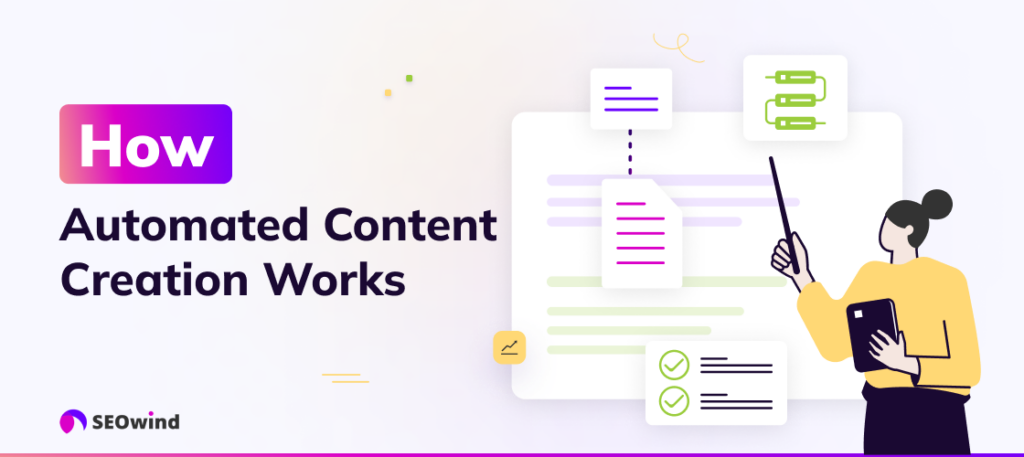
Unearthing the nuances of automated content creation can be as captivating as a detective novel. Let’s probe its underlying mechanisms: AI, machine learning, data collection and analysis, natural language processing (NLP), and various automation tools.
Overview of AI and Machine Learning in Content Creation
AI has positioned itself as the mastermind behind automated content generation. When applied to content creation, machine learning algorithms comprehend patterns and predict future trends based on accumulated sets of data, a process known as predictive modeling. Through continuous learning experiences derived from complex computations, these algorithms aid in composing content that resonates with targeted audiences while honing their skills for better future production.
Data Collection and Analysis for Automated Content Generation
In any conversation about automated content creation, data invariably solidifies its position as a foundational pillar. Think of it this way: crafting engaging content without relevant input is like trying to cook your favorite dish without having all the essential ingredients.
Data collected could range from user behavior metrics, feedback, and social media sentiments to sophisticated market research results. Once gathered, such nuggets are analyzed meticulously to create personalized content that perfectly suits audience preferences. This is a testament to the power wielded by effective data handling within automated content creation systems.
Natural Language Processing (NLP) in Automated Content Creation
NLP brings human-like comprehension to AI systems. Imagine an empathetic friend who listens intently to every word of your conversation to fine-tune appropriate responses. Semantic understanding helps interpret subtle aspects such as context, tonality, or intention hidden within layers of written language.
NLP enables machines to write and read like humans. AI systems with integrated NLP capabilities can generate engaging, well-tuned narratives just like an experienced human author. It is the secret sauce that makes automated content sound natural, coherent, and worthwhile.
Automation Tools and Platforms for Content Generation
The realm of automated content creation is replete with myriad tools, each promising a unique edge in easing content development efforts. Leveraging these technologies can renovate routine workflows, dramatically enhancing efficiency levels.
Let’s discover SEOwind. This platform provides keyword optimization that aids in SEO-oriented automated writing. Or explore Jasper AI’s capabilities to observe how it revolutionizes creative writing using machine learning.
These platforms handle everything from generating topic ideas and crafting human-like text to scheduling posts across various channels, making their presence inevitable in today’s competitive landscape.
Let me wrap up by saying this: the automation wave has hit the shores of content creation, capturing traditional practices in its tide. However, remember that Artificial Intelligence complements rather than replaces the craftmanship of human writers; we are steering towards a harmonious symbiosis rather than competition.
Remember not to lose sight of your unique voice amid all the tech bells and whistles!
Types of AI Content Creation Tools
Text-based AI Tools
Text-based AI tools are at the forefront of automated content creation. These tools use advanced natural language processing algorithms to generate written content, from short social media posts to long-form articles. They can analyze existing content, understand context, and produce human-like text that aligns with specific writing styles and tones.
Image Generation AI Tools
AI-powered image generation tools have revolutionized visual content creation. These tools can create unique, high-quality images based on text descriptions or prompts. They’re particularly useful for creating custom illustrations, product mockups, and visual content for social media and marketing campaigns.
Video Creation AI Tools
Video creation AI tools are becoming increasingly sophisticated, offering capabilities to generate video content from text inputs, create animations, and even edit existing footage. These tools can significantly reduce the time and resources required for video production, making it more accessible for businesses of all sizes.
Audio Generation AI Tools
AI-powered audio generation tools can create voiceovers, music, and sound effects. They’re particularly useful for podcasts, video narration, and creating background music for various types of content. Some advanced tools can even mimic specific voices or create entirely new, unique voices for branding purposes.
Areas to Automate Content Creation
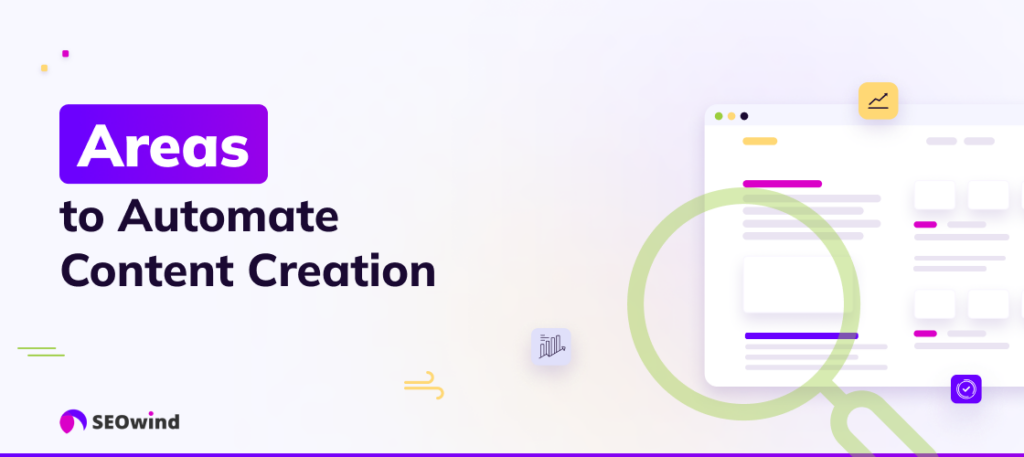
As the world of digital marketing evolves, one thing is clear: automated content creation is a formidable tool in anyone’s marketing arsenal. It brings practical efficiency yet maintains optimal quality. Here’s how you can add an automated touch to different areas of your content creation process.
Keyword Research for Effective Automation
Keyword research forms the bedrock of any successful content creation effort. Machine Learning and AI tools are now readily available to support keyword research automatically, sifting through vast amounts of data and signaling out relevant search terms worth exploring.
Such automatic content generation tools employ advanced algorithms to evaluate competitors’ keyword strategies, trending topics, and semantic relationships between terms. This infusion of technology helps identify high-performing, long-tail keywords that yield favorable SEO results while automating some tedious aspects of keyword identification.
AI-powered Content Generation Techniques
Harnessing the power of Artificial Intelligence (AI) is not a futuristic concept anymore; it’s here, actively helping us bridge the gap between ideation and execution in content creation. With AI-driven platforms like Jasper AI or SEOwind, you can optimize your automated article writing workflow.
Ideal for creating compelling articles or blog posts, these platforms generate unique text that meets defined parameters such as word count or targeted keywords. Trained on extensive datasets means their output often exceeds human-level fluency while consistent with brand voice and style guidelines.
Creating And Utilizing Content Templates
Templates offer structure and consistency when creating multiple pieces with similar themes, which is common in today’s fast-paced online environment. An invaluable use for automation is deploying machine learning algorithms to suggest fitting templates based on previously successful types of content and incorporating them into your automatic content creator workflow.
Using appropriate tags, categories, or keywords on each template type ensures systematic classification that eases future retrieval, saving time whenever similarities among new projects emerge. Ultimately, proper usage will boost productivity and leave enough room for creativity to bloom.
Spinning And Repurposing Existing Content Efficiently
Content spinning is a beneficial strategy that takes an existing piece and transforms it into several unique variants. As part of the content creation automation process, AI-powered spinning tools can interpret context and change phrases without losing their intended meaning, ensuring new material remains plagiarism-free.
However, it’s crucial to check this automated content since current technologies may still misunderstand contextual nuances. Remember that balance and continuous checks aid error minimization!
Curating Relevant And Engaging Content
Curating exciting content that resonates with your audience is vital to engaging online presences. Tools guided by automation can help sift through countless articles, whitepapers, or news updates across wide-ranging digital sources.
Inputting specific criteria such as topic relevance or follower demographics enhances targeted results delivered. For instance, content catering to medical practitioners would require different language choices than material targeting non-specialist readers. Automatic algorithm adjustments shine in these cases!
Automating Editing and Proofreading Processes
Investing in competent automated editing software affords you quality control while saving precious time. These tools leverage Natural Language Processing (NLP) algorithms to detect grammatical hitches and inconsistent punctuation while checking readability scores against target audience literacy levels.
It’s like having a diligent grammar teacher inside your computer, marking red lines on questionable areas! However, end-stage manual reviews remain invaluable for infusing human touchpoints into your generated content.
Visual Content Automation Techniques
The popularity of visual content cannot be overstated; images and videos engage our brains far more effectively than blocks of text alone. By employing AI-based graphic design tools capable of creating visually appealing templates or generating customized graphics based on predefined parameters, the impact gets magnified exponentially.
From optimizing image sizes to adding alt-tags for SEO boost, careful visual curation breathes life into otherwise monotonous walls of text.
Scheduling and Distributing Content Automatically
The content you generate needs a proper schedule to ensure timed distributions align with target audiences’ predictable activity spans. Automation tools help plan this effectively.
Ultimately, scheduled posts drive engagement while keeping your feed lively even when personal engrossments limit active participation.
Tracking and Optimizing the Performance of Automated Content
Finally, recall that automated content creation isn’t a fire-and-forget solution. It craves fine-tuning based on tracked performance metrics. Check how well particular content performs across various channels.
Such data not only improves immediate edit decisions but also informs machine learning algorithms, promoting future improvement potential and essentially closing beneficial feedback loops in your automatic content generator model.
Embracing automation doesn’t imply completely letting go of the reigns. Instead, you should partner with AI for smarter workflows. The harmony between human creativity and intelligent machinery is something worth chasing!
Integrating AI Content Creation with Existing Marketing Strategies
Aligning AI-generated Content with Brand Voice
Integrating AI-generated content with your existing marketing strategy requires careful alignment with your brand voice. AI tools can be trained to understand and replicate your brand’s unique tone, style, and messaging. This ensures that automated content remains consistent with your overall brand identity, maintaining a seamless experience for your audience across all touchpoints.
To achieve this alignment:
- Develop a comprehensive brand voice guide
- Train AI tools using existing brand-aligned content
- Regularly review and refine AI outputs to ensure consistency
- Use AI-generated content as a starting point, adding human touches where necessary
Using AI for Content Ideation and Research
AI can significantly enhance your content ideation and research processes, complementing your existing marketing strategies. By analyzing vast amounts of data, AI tools can:
- Identify trending topics in your industry
- Suggest content ideas based on audience interests and search patterns
- Conduct competitor analysis to find content gaps
- Provide data-driven insights to inform your content strategy
Incorporating AI into these early stages of content creation can help you develop more targeted, relevant, and engaging content that aligns with your marketing goals and resonates with your audience.
Examples of Popular, AI-Driven Content Creation Tools
In our quest to simplify and accelerate the content creation process, different AI-powered tools have taken center stage. Let’s explore three prominent examples: SEOwind, Jasper AI, and Copy.ai.
SEOwind – AI Automated Content Creation
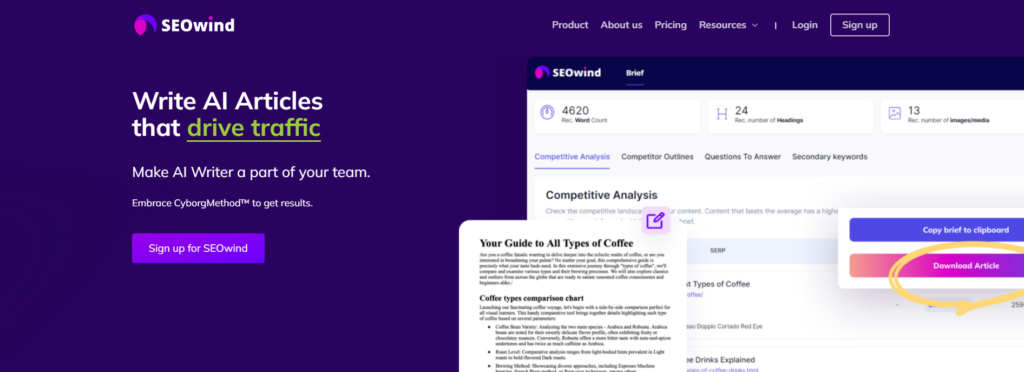
SEOwind has aced the versatility game in automated content production. Specializing not only in creating original articles but also tweaking them for search engine optimization (SEO), this tool sets a high standard for automatic content generation. By scanning databases and mining relevant information from the top SERPs, it effortlessly creates quality and engaging content.
That’s not all. SEOwind further identifies and integrates specific keywords into your content to fuel its visibility on search engine rankings. It also incorporates your tone of voice to make AI content sound like you. How cool is that? Efficient, creative, and mindful of the handy technicalities: that’s how I’d describe this tool!
Jasper AI
Jasper AI is another brilliant tool that harnesses Artificial Intelligence to create compelling written work across diverse formats ranging from emails and blogs to advertising copies! Its built-in advanced features facilitate seamless idea generation and paraphrasing, providing a vast scope for creativity while maintaining exceptional writing standards.
Moreover, Jasper excels at embedding a conversational tone, which makes automated content creation feel much more natural. It boasts excellent user-friendliness, too, with intuitive navigation complimenting its capabilities nicely.
Copy.ai
Wrapping up this list of influential players in automated content generation is Copy.ai, an innovative platform designed with an inclusive understanding of complex language patterns for effectual sentence construction and refinement.
Copy.ai uses sophisticated algorithms to generate engaging text in various styles tailored to suit any context or audience. Plus, its proposals include multiple suggestions per prompt. This aspect ensures both diversity and adaptability in your auto-content generation efforts.
Apart from delivering fascinating copy variants promptly, Copy.ai also lets you automate brainstorming sessions. From catchy social media captions to persuasive product descriptions, this platform has the adaptability and competence to charm your readers with remarkable consistency.
To choose the right tool for your specific needs, you should consider variables such as user interface, intended use, and the effectiveness of each option in complementing your unique content strategy. After all, adequate automation is about enhancing human skills rather than replacing them.
Measuring the ROI of Automated Content Creation
Key Performance Indicators for AI-generated Content
Measuring the return on investment (ROI) of automated content creation is crucial for understanding its impact on your marketing efforts. Some key performance indicators (KPIs) to consider include:
- Content production rate: Compare the volume of content produced with AI vs. traditional methods
- Time savings: Measure the reduction in time spent on content creation tasks
- Engagement metrics: Track likes, shares, comments, and click-through rates
- SEO performance: Monitor organic traffic, keyword rankings, and backlinks
- Conversion rates: Assess how AI-generated content impacts lead generation and sales
- Cost per piece of content: Calculate the overall cost reduction in content production
Comparing AI-generated vs. Human-created Content Performance
To truly understand the value of AI-generated content, it’s essential to compare its performance against human-created content. Consider the following:
- A/B test AI and human-written content to compare engagement rates
- Analyze the quality and accuracy of both types of content
- Compare the time and resources required for each approach
- Evaluate the scalability of AI-generated content vs. human-created content
- Assess the ability of each method to maintain brand consistency
By carefully analyzing these factors, you can determine the most effective balance between AI and human content creation for your specific needs and goals.
Best Practices for Implementing Automated Content Creation
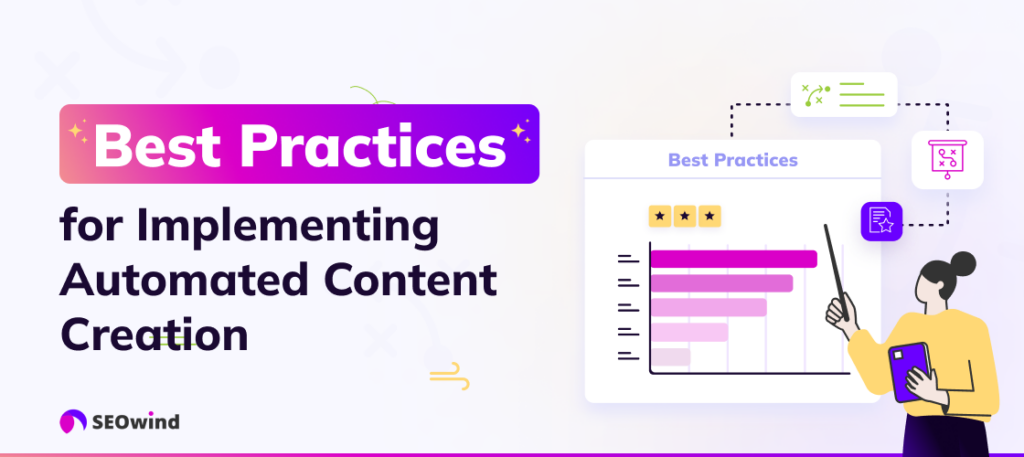
Defining Goals and Objectives for Automation
Before embarking on the journey of automated content creation, it’s crucial to have a clear understanding of what you aim to achieve. Are you looking to save time by automating repetitive tasks? Or perhaps improve consistency in your content production? Pinpoint what drives your need for automation. It could be raising brand awareness, driving website traffic, increasing sales, or even enhancing user engagement.
Remember, having well-defined goals and objectives in place can help determine which content-related activities should be automated and guide decisions regarding the selection of suitable content automation tools.
Identifying Areas for Automation in the Content Creation Process
Once you’ve set your objectives, the next step is mapping out your content creation process. This dissects every step, from ideation, research, writing and editing, visual design, and SEO optimization to publishing and promoting. In each stage, pinpoint tasks that automation can improve. For example:
- Research: Automate keyword searches or trending topics
- Writing: Utilize AI-driven tools for automatic content generation
- Editing: Employ automated grammar and spell-checkers
- Promotion: Automate social media posting schedules
Understanding where precisely to inject technology aids efficiency while maintaining creativity within the process.
Developing a Comprehensive Content Strategy for Automation
Creating a comprehensive strategy requires blending your established goals with areas identified for automation into one cohesive plan that outlines how technology will support your overall business objectives.
Firstly, define the kind of articles you want to produce—blogs, how-to guides, or product descriptions—and identify who they are tailored for. Different audience segments might require different types of content. Then, elaborate on style elements like tone and voice, aligning them with branding guidelines while setting frequency benchmarks, such as weekly blogs or daily social media posts, and ensure the approach remains flexible enough to accommodate future tweaks.
Prioritizing Personalization and Relevance in Automation Efforts
Automated content creation should never equate to generic, run-of-the-mill content. Consumers today value personalized experiences more than ever, and your automation strategy should consider this. Leverage AI-powered tools that enable dynamic personalization, tailoring pieces based on user behavior or preferences, thus boosting relevance and engagement.
Moreover, understanding trending topics within your industry can ensure automated content stays relevant, keeping it fresh while resonating with the readers’ interests.
Maintaining Quality Control in Automated Content Creation
As wonderful as technology might be, there’s no substitute for the human touch when ensuring content quality. Regularly review auto-produced articles to confirm they align with your mission and brand voice. Insist on manually approving critical publications before they hit publishers’ desks.
Remember to also track performance metrics: traffic numbers, bounce rates, and social media shares, among others, will reflect whether your audience is indeed finding the content valuable or if you need to adjust the parameters for automatic content generation.
Monitoring Performance and Optimizing Automated Content
As we venture deeper into the landscape of automated content creation, let’s pause to consider an imperative aspect: monitoring performance. Just as a gardener keeps a keen eye on his plants, watching their growth and vitality, it is essential for you, too! Remain vigilant with your auto-generated content by analyzing key metrics such as engagement rates, click-throughs, or conversions.
Efficient use of analytics can help you comprehend what works and what doesn’t in your automated content strategy. Implement changes based on these insights for optimization. Remember that success in the realm of automating content creation lies not just in creating but also scrutinizing and improving.
Choosing Suitable Content Automation Tools
Imagine yourself standing in an art supply store with various paint colors around you. How do you choose? Well, the answer depends on your needs. It’s the same with content automation tools!
When selecting your automated content production software, consider aspects like user-friendliness, algorithmic sophistication, and scope for customization. Explore different platforms before deciding. Tools like Jasper AI or SEOwind offer unique features fit for diverse requirements.
Don’t lose sight of your goals while being swayed by flashy features. Stick to what most effectively supports your objectives for automated article generation or general content automation.
Training Team Members to Utilize Automated Content Creation Tools Effectively
What good is a powerful Ferrari if its driver cannot steer properly? The same principle applies to sophisticated technology; without adequate training and understanding, even the most advanced content automation marketing tool might underperform or even backfire!
Empower team members with proper knowledge about your chosen automated creation tools. Conduct workshops and webinars focusing on both theoretical aspects and hands-on practice sessions. A well-prepped team can navigate even perilous terrain with flair!
Balancing Automation with Human Creativity
While the wonders of automated content production cannot be overlooked, let’s remember the unique flavors human creativity provides. It is crucial to strike a harmony between both: automate content creation processes where possible and let unfettered imagination take charge elsewhere.
Combine the accuracy of AI-driven keyword research with an author’s intuitive sense for crafting resonant narratives. Maintain a balance between consistency borne from automation and the authenticity of the human touch for a brew that promises success.
Continuously Iterating and Improving Automated Content Creation Processes
Lastly, remember there’s no “set-and-forget” approach here; your journey in auto content generation requires constant tuning.
Monitor evolving market trends, revise your strategy accordingly, and adapt swiftly. Whether tweaking SEO keywords or redesigning entire templates, each iterative improvement can inch you closer to perfection.
When automating content creation, remember these guiding lights: vigilant monitoring and optimization, well-chosen tools chosen to fit your needs, a skilled team utilizing technology efficiently, harmonious balance between man and machine, and relentless pursuit of improvements!
Challenges in Automated Content Creation

Automated content creation comes with several challenges. These obstacles can hinder a seamless transition to a more AI-driven approach. Let’s review how to address them.
Ensuring the Quality and Authenticity of Generated Content
The most apparent challenge that rattles every content creator who embraces automation is maintaining quality and authenticity. Automated content generation tools are remarkably efficient, but they may occasionally miss the mark on originality and quality.
Remember that duplicate or subpar content on your website can attract search engine penalties, furnish lower click-through rates (CTR), and eventually lead to decreased visibility over time. In addition, low-quality auto-generated content stagnates user engagement metrics such as dwell time and can tarnish your brand reputation, making it appear less trustworthy to visitors.
Therefore, you should not fully automate content development. Scrutinizing generated content ensures it aligns with your definition of quality: grammatically unsurpassed, factually accurate, logically sound, and engagingly pertinent.
Maintaining Brand Voice and Consistency
Another hurdle in automating content creation is keeping your brand voice consistent across all channels. Your brand voice communicates your business values and personality. But to do so, it must remain consistent whether you’re writing an article or posting an image caption.
Inconsistencies within your brand communication can distort what you represent and impair customer perception substantially. Automation tools shine when churning out vast volumes quickly; however, they occasionally struggle to inject your unique brand voice into each piece of content.
Module-defined guidelines within automated systems can help overcome this obstacle. Use templated responses filled with pre-approved language specific to various scenarios.
AI Bias and Ethical Concerns in Automated Content Creation
An often overlooked aspect of AI writing is the biases that seep into automated content production. AI draws conclusions based on the data it’s been fed; if a bias exists in that data, the likelihood of producing skewed content is high. Consequently, it unfairly caters to a specific population segment.
And once installed, these biases are hard to erase because they’re a central part of how algorithms learn. It can lead to misrepresentation or exclusion, creating ethical dilemmas in your content.
Understanding this issue requires monitoring AI operations vigilantly and implementing strict regulations around potential bias considerations during the automation process. Upholding ethical standards while using automatic content generator tools is fundamental to building equity for your brand and maintaining trust with your audience.
These challenges might seem daunting initially, but every evolution comes with hurdles! Following strategic steps can ensure you leverage the transformational power of automated content creation while remaining authentic and ethically sound.
AI Content Creation for Different Industries
E-commerce
AI content creation tools are revolutionizing the e-commerce industry by:
- Generating product descriptions at scale
- Creating personalized product recommendations
- Crafting engaging email marketing campaigns
- Developing chatbot scripts for customer service
These applications help e-commerce businesses save time, improve customer engagement, and increase sales.
B2B Marketing
In the B2B sector, AI content creation is being used to:
- Produce industry-specific whitepapers and case studies
- Generate personalized sales pitches and proposals
- Create targeted LinkedIn content for lead generation
- Develop data-driven market analysis reports
AI tools help B2B marketers create more relevant, persuasive content that resonates with their professional audience.
Media and Publishing
The media and publishing industry is leveraging AI content creation for:
- Generating news summaries and updates
- Creating data-driven financial reports
- Producing localized content for different markets
- Automating content curation for digital platforms
These applications allow media companies to increase their content output while maintaining quality and relevance.
Future Trends and Innovations in Automated Content Creation

Envisioning the future can be thrilling, especially when discussing technological advancements. Let’s take a look at several promising trends that demonstrate the remarkable potential of AI content.
Fine-tuned Natural Language Processing
At the core of any automatic content-creator tool is Natural Language Processing (NLP) technology, which allows computers to understand, interpret, and generate human language. Moving forward, enhancements in NLP technologies will facilitate even more sophisticated sentence structures and vocabulary usage, giving birth to a new era of convincingly human-like automated article genesis.
Personalized AI Narratives
Personalization has long been a popular trend in marketing, and it’s becoming increasingly prevalent as we advance deeper into the digital age. Wave “Bonjour” or “Hola” to an era in which content will not just be generated automatically but attuned to user location, preferences, and behavior patterns! Advanced algorithms are poised to create highly personalized narratives that resonate with specific target audiences.
More Interactive Content
Change is always right around the corner when it comes to technology. However, one thing remains consistent: people love interactive content! Advanced image recognition and augmented reality software offer exciting opportunities for visual content automation. For instance, imagine blog posts spruced up with engaging virtual graphics that users can manipulate!
Enhanced Creative Options
The future is full of creativity via Graphic Interchange Format (GIF), video generation capabilities, and audio narrations by text-to-speech AI models, among others.
Imagine writing a script for your next YouTube tutorial video and then letting an Azure model convert it into an immersive video complete with related imagery and voice narration, all within minutes.
Through these exciting innovations in automatic content creation tools, we can see how AI isn’t simply here to replace content creators. Instead, it augments their potential, enabling them to operate more efficiently and innovatively. It’s clear the automation train is going full steam ahead! So fasten your seat belts because the ride has just begun.
Keep an eye on these trends as they shape the future landscape of automated content creation. The possibilities are endless, and we can’t predict everything. However, one thing’s certain: change is constant, and those who adapt will come out on top in this exciting age of automated content production.
Overcoming Writer’s Block with AI Content Creation Tools
Writer’s block can be a significant obstacle for content creators, but AI tools can help overcome this challenge. Here’s how:
- Idea generation: AI tools can suggest topics and angles based on trending subjects and your target audience’s interests.
- Outline creation: AI can help structure your thoughts by generating article outlines.
- Research assistance: AI can quickly gather relevant information and statistics on your chosen topic.
- Sentence starters: When you’re stuck, AI can provide opening lines or paragraphs to get you writing.
- Paraphrasing: AI tools can help rephrase existing content to spark new ideas.
By leveraging these AI capabilities, content creators can maintain productivity even when inspiration is hard to come by.
The Role of Human Editors in AI Content Creation Workflows
While AI content creation tools are powerful, human editors still play a crucial role in the content production process:
- Quality assurance: Human editors ensure that AI-generated content meets quality standards and brand guidelines2. Fact-checking: Editors verify the accuracy of information provided by AI tools.
- Tone and voice refinement: Human editors adjust the content to ensure it aligns with the brand’s unique voice and style.
- Contextual understanding: Editors provide nuanced interpretations that AI might miss, especially for complex topics.
- Creative enhancement: Human editors can add creative elements and personal touches that AI may not replicate.
- Ethical oversight: Editors ensure that AI-generated content adheres to ethical standards and avoids potential biases.
By combining the efficiency of AI with the expertise of human editors, organizations can create high-quality content at scale while maintaining authenticity and brand integrity.
AI Content Creation for Multilingual and Global Markets
AI tools are revolutionizing content creation for global audiences:
- Automated translation: AI can quickly translate content into multiple languages, maintaining context and meaning.
- Localization: Advanced AI tools can adapt content to suit different cultural contexts and preferences.
- SEO optimization for different languages: AI can suggest keywords and optimize content for search engines in various languages.
- Consistency across markets: AI ensures brand messaging remains consistent across different languages and regions.
- Scalability: AI enables businesses to produce large volumes of multilingual content efficiently.
By leveraging AI for multilingual content creation, businesses can expand their global reach and engage with diverse audiences more effectively.


